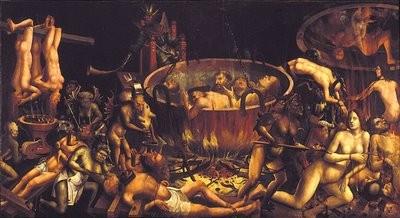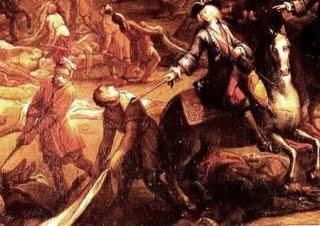The moral economy of witchcraft: an essay in comparative history - II
2. The moral economy debate: microeconomics and culture
The central trope of the various efforts to define moral economy has been an opposition between, on the one hand, the maximizing individual and ever-expanding market of classical political economy, and on the other a community governed by norms of collective survival and believing in a zero-sum universe: i.e. a world where all profit is gained at someone else’s loss. The communal/zero-sum side of this equation is broadly consistent with African beliefs identifying capitalism and witchcraft as the dangerous appropriation of limited reproductive resources by selfish individuals. The great danger of such a set of dichotomies is that it may remain trapped where it first originated, within the discourse of capitalism itself. Exotic economies thus become constructed around either a market/non-market opposition or a subsistence-based variant of market rationality. In analyzing the history of societies confronting capitalism, even from the outside or the bottom, one cannot reject out of hand all references to capitalist terms. But a cultural account proceeding entirely on this basis represents a concession to the very hegemony which moral economy is supposed to be contesting.

The term “moral economy” actually came into wide scholarly use through the study of early capitalist Europe, specifically with E.P. Thompson’s writings on eighteenth-century Britain (Thompson 1968: 225-26, 1971); its application to the Third World awaited the somewhat later book of James Scott (1976). Scott, according to his references, was indeed inspired by Thompson; yet Thompson had predecessors who were more concerned than he with non-western economies and remain more directly relevant to the genesis of moral economy theory and its role in studying Africa.
It was the substantivist economics of Karl Polanyi1 and his associates (1957) which initiated a sophisticated argument among anthropologists and historians about the relevance of market models to the study of economies outside of the modern West (LeClair and Schneider 1968; Hopkins 1973; Dalton 1976). The substantivists, who questioned those models, ultimately lost most of the arguments. On an abstract level, their “non-market” terms (derived from a somewhat naive reading of structural-functionalist anthropology) were easily converted into “collective utilities”; more concretely, what substantivists defined as uniquely Western market behavior could be documented in large portions of “primitive” and “archaic” Africa. Polanyi’s explicitly Aristotelian critique of profit-seeking is a perfect example of what Bloch and Parry (1989: 2f.) identify as a fatal ethnocentrism in interpreting “the morality of exchange” in societies outside Europe. Nonetheless, the concept of how markets may be “embedded” in other systems of hierarchy, distribution and value remains— when understood less rigidly than Polanyi did— a useful tool for analyzing the relationships between individual acquisitiveness and witchcraft (see below).
The more robust notion of a zero-sum universe as the basis for “traditional” economic behavior derives from the ethnographic work of George Foster (1965). Foster argued that peasants everywhere experience a world of “the limited good”2 but he regarded such attitudes as obstacles to both progress and true communal cohesion, much as did the more acerbic Edward Banfield (1958). Foster and Banfield are rarely cited in moral economy literature because their developmentalist outlook fits ill with the ideological stance in most of this writing; however, their vision of negative utilitarianism states most clearly its underlying premises.
Thus, in his original formulation of moral economy, Scott attributes to Third World (and even European) peasants a formal economic logic which is far more akin to the approach of the unnamed Foster than to the acknowledged Thompson and Polanyi. Having decided that these cultivators maintain a “subsistence ethic,” Scott undertakes what he considers a sympathetic analysis of their actions by replacing the motive of profit-maximization with one of risk-aversion (Scott, 1976, 4, ff.). It was thus possible for Popkin (1979) to produce a work ostensibly criticizing Scott for neglecting evidence of profit-oriented entrepreneurship in peasant communities, while actually providing a very similar picture of the calculations underlying rural Southeast Asian responses to colonial capitalism (Hunt, 1988).
Scott (1985) has himself recognized that his earlier formulations were overly abstract and too focused on explaining the relatively rare occurrence of peasant revolt; his newer work thus contributes to a version of the moral economy argument revised in both method and vision (cf. Roeder 1984, Berry 1985, Magagna forthcoming). The basis for these more recent studies is a combination of intensive village fieldwork (even by Scott, a political scientist) and detailed historical research. No longer is the “essential” need of the pre-modern rural small-holder seen to be subsistence; it is now security, sought by contesting the dominant order through complex processes of patronage-clientage, small-scale (often hidden) rebellion or resistance, and the claim to overlapping rights in vital property. Thompson’s early (1971) formulation of moral economy fits this model well; the British crowds he describes appeal against unregulated market prices both to abstract principles of communal needs and to established paternalist norms and practices.

In its more nuanced versions, the moral economy perspective is less open to empirical criticism from rational choice advocates and can provide rich accounts of the devices by which communities reproduce complex relations of dependency (Berry 1985). But the ability to bring cultural analysis into these efforts remains limited; Scott’s Weapons of the Weak depicts peasants whose poverty extends to their inability to offer any compelling description of the larger world in which they are encompassed and Berry sees the commitments of Yoruba entrepreneurs to village investments mainly in terms of her own norms of productivity. Perhaps the most successful treatment of culture is found in Magagna’s discussion of proto-industrial England, where the values expressed in village charivari and “alehouse discourse” are successfully incorporated into the rural negotiations of such capitalist incursions as enclosure. Missing in this argument, however, is any serious attention to witchcraft, the very feature of the cultural landscape in early capitalist Europe most open to comparison with Africa.
The concept of moral economy thus has serious shortcomings; even in Europe, where it has proven most useful, it leaves unexamined the cultural dimensions of capitalism and its opponents. Nonetheless, the moral economy school has a good deal to teach those more seriously concerned with culture. Most obviously, it demands that attention be paid to the conditions of access to material resources which determine, with some degree of autonomy, the understandings of capitalism possible within any community. Furthermore, in the revised versions it provides detailed, socially sensitive accounts of political and economic strategies which illuminate any discussion of ideology.